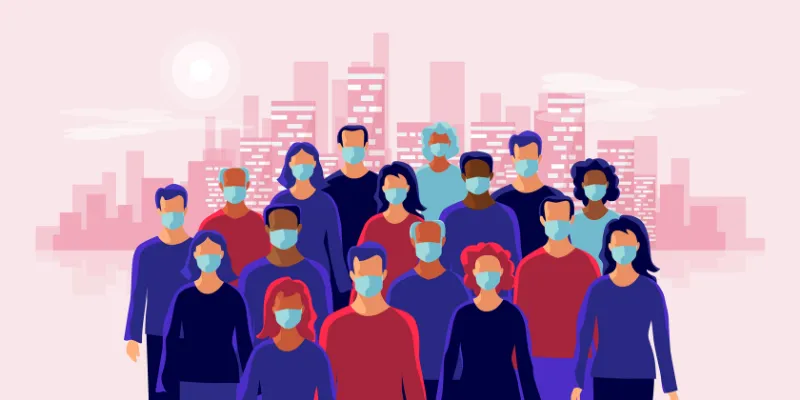[MatrixMoments]: How different sectors will look once the coronavirus lockdown is lifted
In this episode of #MatrixMoments, Rajinder Balaraman, Director, Matrix India Partners, discussed what startups should expect once the threat from the coronavirus abates. Guests included Matrix India Partners Avnish Bajaj, Founder and MD, Rajat Agarwal, Gourav Bhattacharya, Sanjot Malhi
The impact of the coronavirus pandemic is already visible on the global economy – oil futures have turned negative, stock markets around the world have taken a beating, and there have been layoffs across multiple sectors and businesses.
And while startups currently are focused on survival, in this episode of Matrix Moments, the investment team of Matrix India Partners – comprising Avnish Bajaj, Founder and Managing Director, and Rajat Agarwal, Gourav Bhattacharya and Sanjot Malhi, Directors – talk about the possible impact the virus will have on different industries, and what companies should focus on.
Kicking off the episode, Avnish says the world hasn’t seen a crisis of this magnitude before, but the actions the founder-community has taken is impressive.
“To see the kind of reaction very proactively from the founder community has been very inspiring because they are the ones facing it. We can all sit here and give “gyaan” (knowledge) sessions, but they are the ones feeling the daily pain.”

Startups have been plagued with concerns of their futures amid all the uncertainty the outbreak has caused, and they’re now wondering what they need to do to survive. Some, though, are wondering if this is an opportunity in disguise, while others are worried how investments in their sector will be affected.
Matrix’s investment team believes that, due to the pandemic, businesses overnight have gone from hundred to zero in terms of scale and growth. They believe that mitigating any more risks is the only way startups in a COVID-19 world can survive.
Ecommerce could recover in phases
Gourav says that while the ‘essentials’ category has seen an upswing in orders on ecommerce platforms, what has been impacted the most is the non-essentials.
“Unfortunately on the non-essentials side, the issues are a little bit deeper because not only are these companies not able to service the demand, but from what we're seeing – in terms of the US and China – the demand is likely to be broken even once we get out of the lockdown. I think that's a deeper set of issues that these companies need to solve,” he adds.
Also, now, with a clear distinction between essentials and non-essentials, it has become clear that “essentials” are better-positioned, and, in some ways, are mostly tailwinds for ecommerce companies.
With this focus on essentials because of the coronavirus, there has been a realignment of human behaviour in terms of how we spend money and time, says Sanjot.
“The product-market fit of pre-COVID-19 days may not exist after,” he adds. This has got a lot to do with cash flow management, says Sanjot, because having enough cash in the bank to survive – and see it through any crisis – is going to be imperative.
“I think during the initial lockdown, a lot of companies were thinking about conserving cash, extending their runways for the foreseeable future – ideally a year – and that meant relooking at fixed and variable costs, working capital, etc, with a fresh lens,” he says.
Conserve cash as a principle
Non-essential companies will need to rethink their position in the new world, and business will be about survival, the team believes.
“I think the new mantra will be conserving cash to survive, and (companies will have to prepare for this) by sharpening the blade. It could be thinking about what your customer needs are going to be in the new world and how are you adapting to meet that need,” says Sanjot.
For essentials, the focus is going to be on supply.
"I think there are big macro factors that affect supply, one of them being the monsoon season. We’ve also recently seen a mass migration from urban to rural areas, and we don't know what impact that has on the harvesting season. Those are all “watch-outs” for founders, says Gourav, adding the main focus immediately after the lockdown would be redundancies and order fulfilments."
A shift in models
There already are large-demand stimulation exercises being planned by the likes of Flipkart, and Amazon, which have decided to host sale-events once the lockdown lifts.
But one needs to accept that demand – at least for the next 12 to 18 months – would be almost 50 percent lower in most categories, than what it was earlier.
“Post COVID, startups will need to look at a mix of different things - new opportunities, how are they going to approach the market, rediscover PMF within small sub categories, and even possibly re-looking at new categories,” adds Gourav
Shift in lending as a business
Financial services, especially lending, has taken a battering during the lockdown, and companies have put in a lot of effort over the last few weeks to come to terms with that, and figure out defence strategies.
“Largely for me, two things truly stood out over the last few weeks – one is that, lending is no longer a balance-sheet business, but a cash flow business, where it is imperative for companies to match incoming and outgoing cash flows. Thus, rather than focussing on costs and collections, it is important to look at supply. But that isn’t easily available,” says Rajat.
Steps need to be taken to restructure loans, and the next few weeks are going to be critical for lenders, he adds.
The next focus needs to be on risk models.
“Despite whatever we say, there is an over-reliance on credit bureaus and credit scores, and that just doesn't make sense anymore. Credit scores don't take into account the future dashboards, and so, erstwhile safe segments are not going to be safe anymore,” quips Rajat.
“What do you really do when salaried employees of blue chip companies are being laid off? How do you lend to them? So companies need to take a very hard look at risk.”
Lastly, in some sectors, close to 40 percent people would have taken moratoriums. The load on collections systems will be immense once the moratoriums period gets over. Companies need to bolster their collection systems, maybe retrain existing salespeople, to do collections in this time.
The shift in mobility
Younger mobility companies today are thinking through their product-market fit, and Rajinder believes the focus of the mobility sector should strongly shift towards health and sanitisation.
“While there still maybe impact on demand, the focus will be on quality of the ride-hailing experience. Anything that mobility platforms are able to do to augment supply, and augment driver incomes, as partner-incomes, is really key,” adds Rajinder.
While the government is already planning an ‘exit strategy’ – like green zones and red zones, post lockdown – it is important for startups to think of the same.
“Before getting to a tactical exit strategy, it is important for founders to see if they have a defence that is really thought through. They need to see if their PMF has held or not. In a post COVID-19 world, the market will be different across sectors,” says Avnish.
Gradual recovery
Once the lockdown lifts, with people going back to work, sectors like mobility will bounce back. But discretionary spending – like going to a shopping mall, restaurants, and travel – is going to take more time to recover.
Zonal demarcations may still cause delivery and movement issues.
Avnish believes that each turnaround will be different for different sectors, and if, for instance, there’s a new rise in infections, recovery could be impeded again.
“As they're planning their exit strategies, I think founders should be prepared that it’s not going to be fully ‘on’. We want to turn ‘on’ in phases, and be prepared that things might go ‘off’ again,” he adds.
Edited by Aparajita Saxena


![[MatrixMoments]: How different sectors will look once the coronavirus lockdown is lifted](https://images.yourstory.com/cs/2/f02aced0d86311e98e0865c1f0fe59a2/coronavirushumanity-1586326999076.png?mode=crop&crop=faces&ar=2%3A1&format=auto&w=1920&q=75)
![[Matrix Moments] How coronavirus will continue to impact India’s fintech ecosystem](https://images.yourstory.com/cs/2/604090802d6d11e9aa979329348d4c3e/Fintech-1587135875515.png?fm=png&auto=format&h=100&w=100&crop=entropy&fit=crop)
![[Matrix Moments] Costs can be controlled; revenue can’t, says Avnish Bajaj, Matrix Partners India](https://images.yourstory.com/cs/2/b87effd06a6611e9ad333f8a4777438f/Imaget78r-1585817065382.jpg?fm=png&auto=format&h=100&w=100&crop=entropy&fit=crop)
![[Matrix Moments] Our job is to continue to invest in cycles, says Avnish Bajaj on coronavirus impact](https://images.yourstory.com/cs/2/e641e900925711e9926177f451727da9/WhatsAppImage2020-03-19at8-1584987702068.jpeg?fm=png&auto=format&h=100&w=100&crop=entropy&fit=crop)




